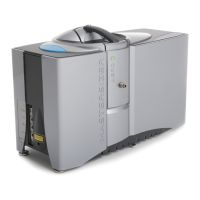Chapter 4 Making measurements
Page 4-10 MAN 0474
can be added to the Trend view, for example to see how Ultrasound Power settings
are affecting the measurement.
By default, each measurement’s Dv10, Dv50 and Dv90 figure is shown, so it is very
simple to make a quick assessment of the result. The Dv50 category shows the
median particle size. Further statistics and measurement parameters can also be
viewed on the Trend view.
Once a number of measurements have been performed, it is possible to select mul-
tiple records in order to view combined figures for the range. It is also possible to
modify the data displayed on the graph, and add entirely new graphs with a differ-
ent focus of interest if required.
This is an example of the trend view after four measurements have been made. The
currently selected range in this example includes just two records: Record Number
2 and 3 - the figures displayed in the coloured boxes relate only to those two
records.
Statistics shown in the live trend view
The live trend view identifies each line with a key, which shows statistical informa-
tion about the measurement:
The data shown relates either to the individual measurement or range of measure-
ments selected by the user. The default view shows particle size statistics. Trend
plots can be configured to show any parameter – the statistics shown on a plot line
relates to a single parameter only.

